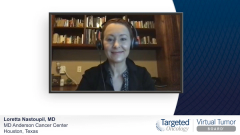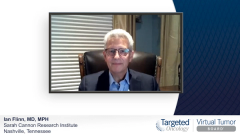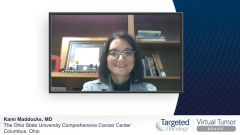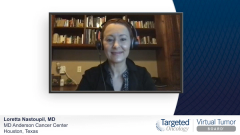
Case 2: Therapeutic Options in Patients With Transplant-Ineligible, Treatment-Refractory DLBCL
Episodes in this series

Kami Maddocks, MD: This was mentioned by Loretta. You said that most patients are going to do well with R-CHOP [rituximab, cyclophosphamide, doxorubicin hydrochloride (Hydroxydaunomycin), vincristine sulfate (Oncovin), prednisone] and that’s true. What percentage of patients in your practice do you find are refractory to front-line, either progressing in therapy or don’t get into remission, versus those that relapse within the first year or two?
Jason Westin, MD, MS, FACP: Rare. I was going to say, it’s rare to have totally refractory. This patient progressed during therapy, that’s uncommon. And that is a pattern we do see with patients with double hit lymphoma, that they’ll have an early response and then a progression, and perhaps there’s a chemotherapy refractory clone that just took time to grow out to be the dominant clone. But primary refractory or progressing during therapy, it happens. I’d say it’s less than 10% of cases, but it’s a poor prognosis.
The second scenario you mentioned, Dr Maddocks, is somebody progressing after achieving response is more common and would have a better chance to respond to second chemotherapy. These people that are primary refractory to R-CHOP, they’re unlikely to respond to salvage chemotherapy because there’s something innately chemo-resistant about their disease.
Kami Maddocks, MD: Ian, did you have a comment?
Ian Flinn, MD, MPH: No. Jason’s analysis is correct. We often feel obligated if someone has primary refractory disease to try to salvage it with a second-line treatment. And that’s generally unproductive and doesn’t work. If they’re trying to get that patient to CAR [chimeric antigen receptor] T cells is where we would go next, if the patient was eligible. In this case this patient is probably not a great candidate for intensive therapies in the future given his complaining of chest pain. He’s 78, he’s got renal insufficiency, and he may not be the best candidate for the next line of treatment.
Kami Maddocks, MD: What option for treatment does this patient have? He is older, maybe some more medical comorbidities. How do you approach this patient?
Ian Flinn, MD, MPH: It’s similar to discussions we had before—is the goal still cure? Or is the realization that it’s not likely to happen in this patient? Given the primary factor, the nature of this disease, the patient’s comorbidities, we’re probably not talking about a curative therapy in this patient population. The next generation of CAR T cells are getting easier and easier. But, the ones we have today are still quite difficult to administer to this patient.
I would, think some of the other options that we have are relatively new approved options, and some old ones. For instance, you could go to a second-line perhaps less intense salvage therapy such as R-GemOx [rituximab, gemcitabine, and oxaliplatin]. You could switch to one of the newer approved therapies such as BR [bendamustine] polatuzumab. There is the tafasitamab and lenalidomide that’s recently been approved. There are a number of options for this patient, but you have to make a decision what the goals are for this patient.
Kami Maddocks, MD: We’ll talk about a little later what is the auto eligibility, a patient who is eligible for auto-transplant versus CAR T. Is it the same thing, is it different? And there’s no boxes that you can check to ensure that a patient is going to be eligible for one or the other. But what are some of the things that you look at when that patient is sitting in front of you to make a decision but you’re thinking, 1 of that type of curative therapy versus a more palliative approach?
Loretta Nastoupil, MD: Someone like this who’s progressing amid CHOP, my enthusiasm about salvage chemotherapy, age aside, is quite low. Then you throw in a 78-year-old who is going to be particularly nervous about heading down the path of platinum-based treatment. Am I really going to pursue high-dose therapy. Though we don’t have an age limit, and I recognize that it is a functional status and we decide who is going to move forward with auto-transplant in the US, I have not taken may 75-plus-year-olds to transplant because I haven’t seen many of them, particularly in this setting, do well with salvage chemotherapy.
This is someone I would start thinking about CAR T. I think the eligibility is quite different. You have chemotherapy sensitive disease; you go forward with transplant. If you have a patient who’s not chemotherapy sensitive or chemorefractory, I think CAR T. But, even without knowing the results of the randomized phase 3 studies, this is a patient I might have to cool off or stabilize before I get to a CAR, particularly from an autologous T-cell situation.
This is a situation where I might try one of the newer agents that are available. We have, Peter had played around a little bit with the polatuzumab-rituximab and hold the bendamustine until you capture or collect those T cells. That might be a strategy I might employ.
You’ve heard about tafasitamab, lenalidomide. We don’t know how well that performs in a refractory situation. I mean that’s another tool in our toolkit that we might start exploring, can we stabilize these patients? And if they respond, do you even need to go down the path of CAR or something that might be more definitive?
I would not even pursue salvage in this case. I would pursue one of the available targeted agents in the second line hoping that a different mechanism of action might turn this around. And I don’t think I would pursue transplant even if I got into a complete response situation.
Jason Westin, MD, MS, FACP: I agree. And the only thing I would add is that there’s not an upper age limit for CAR T-cells. This patient is medically frail with a chest pain, as Dr Flinn mentioned, the renal insufficiency. Those are factors that are going to potentially increase the morbidity from a CAR T cell. The eligibility for this patient to go for CAR T cell is going to be borderline. But we’ve treated patients into their late 80s with CAR T cells, none of whom is completely; you know an Olympic athlete, they all have challenges. They’re usually quite fit for their age. However, the CAR T cells are not the same patient population as the transplant patients. Evaluation by a CAR T-cell center, if you’re even considering it, is a good idea. But the targeted approach is probably the best for this particular patient.
Transcript edited for clarity.














































